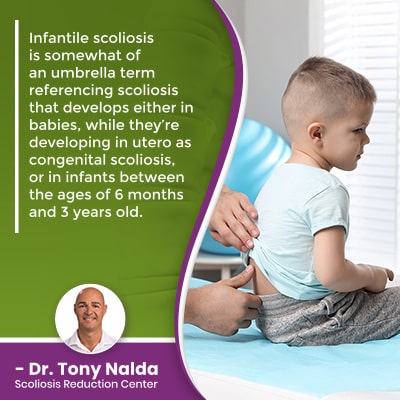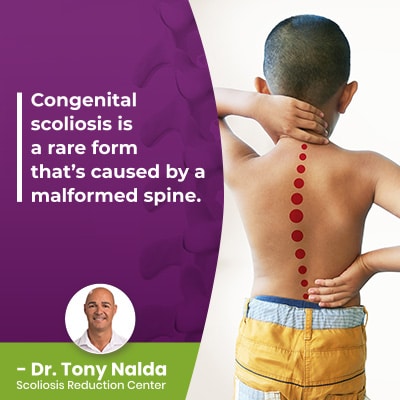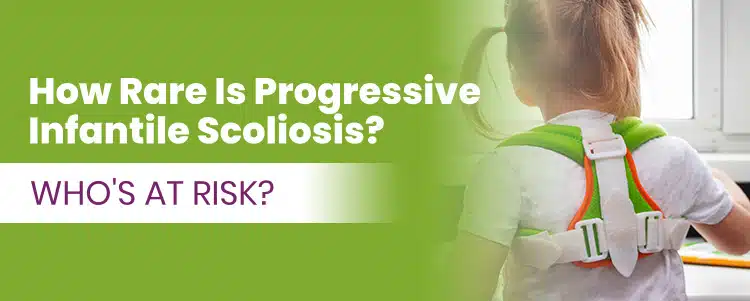Scoliosis can affect all ages from infants to the elderly and every age in between. Part of the reason scoliosis requires the care of a specialist is because no two cases are the same, so treatment plans need to be fully customized.
Infantile scoliosis is diagnosed between the ages of 0 and 3 years of age and can include congenital scoliosis that develops in utero, and infantile scoliosis that isn’t congenital: idiopathic in nature. Infantile scoliosis is rare with a rate of approximately one percent.
As we’re talking about infantile scoliosis, let’s start by exploring the different condition types and age groups they affect.
Scoliosis and Age
As mentioned, scoliosis affects all ages, and part of diagnosing conditions involves comprehensive assessment so they can be further classified based on key patient/condition variables.
Age is a key factor for a number of significant reasons; as a progressive condition, scoliosis has it in its nature to get worse over time, and this means the size of the unnatural spinal cure is going to increase, as will its effects.
While there are never treatment guarantees, in cases that are detected early and treated proactively, there are fewer limits to what can be achieved, and when it comes to addressing scoliosis in children, it should be taken seriously.
As a progressive condition, the best time to start scoliosis treatment is always now.
In the majority of scoliosis cases, approximately 80 percent, conditions are classified as idiopathic, and this means not clearly associated with a single-known cause, but while we don’t always know what causes scoliosis to develop initially, we do understand what triggers it to progress: growth and development.
So the more growth a patient has yet to go through, the more potential progression there is because growth is what causes the condition to get worse: another reason childhood scoliosis needs to be taken seriously and treated proactively.
In fact, what I really want parents and/or caregivers to be aware of is the importance of scoliosis screening because early detection isn’t always easy to achieve, but it does increase the likelihood of treatment success.
In adults, the focus of treatment can shift because the trigger of growth is removed, so while they still progress, it tends to be at a slower rate, and the focus of treatment in adult scoliosis is more to reduce a scoliotic curve back to where it was prior to becoming painful.
So let’s now briefly touch on the different condition types, and the ages they affect.
Different Types of Scoliosis
Condition type is determined by causation, and 80 percent of known cases have unknown causes, and the remaining 20 percent are associated with known causes: neuromuscular scoliosis, degenerative scoliosis, and congenital scoliosis.

Idiopathic scoliosis is the most common type of scoliosis to affect both children and adults, and the most common condition type overall is adolescent idiopathic scoliosis (AIS), diagnosed between the ages of 10 and 18.
Neuromuscular scoliosis is caused by the presence of a larger neuromuscular condition such as spina bifida, muscular dystrophy, and cerebral palsy.
My neuromuscular scoliosis patients are more complex to treat because the underlying neuromuscular condition has to be the focus of treatment, and these conditions tend to be severe.
Degenerative scoliosis is caused by natural age-related spinal degeneration, and when it comes to treatment, the focus is on preserving spinal health and function, providing pain relief, and increasing spinal support and stabilization.
Congenital scoliosis is a rare form that’s caused by a malformed spine.
What is Infantile Scoliosis?
Infantile scoliosis is somewhat of an umbrella term referencing scoliosis that develops either in babies, while they’re developing in utero as congenital scoliosis, or in infants between the ages of 6 months and 3 years old.
Cases of congenital scoliosis are rare, affecting approximately 1 in 10,000 infants.
Congenital scoliosis is caused by a malformed spine that develops in utero, so infants are born with the condition, and in these types of cases, it can be common for other malformations to be present within the body so comprehensive assessment and monitoring is necessary.
When a healthy spine forms, its vertebrae are rectangular in shape (bones of the spine) so can be stacked on top of one another in a straight and neutral alignment, and in some cases of congenital scoliosis, one or more vertebral bodies are more triangular in shape.
Triangular-shaped vertebrae mean sharp angles that cause the vertebrae to stack differently, and not in a straight alignment, and the spine forms with an unnatural spinal curve as a result.
In order for the spine to be as strong, flexible, and functional as possible, it has to be aligned with its natural and healthy spinal curves in place; if the spine loses one or its healthy curves, the biomechanics of the entire spine are disrupted.
So in cases of congenital scoliosis, we know what causes it, but what about scoliosis that seems to develop between the ages of 6 months and 3 years?
Progressive Infantile Scoliosis
In cases of infantile scoliosis that didn’t develop in utero, this is idiopathic, and progressive infantile scoliosis refers to the condition’s progressive nature; however, there is research showing that some cases of infantile scoliosis resolve on their own, not becoming progressive with growth.
The reality, however, is that many cases of infantile scoliosis do progress, and there is no way to determine which will resolve on their own, and which will require proactive customized treatment, and this is why monitoring closely for signs of progression is important.
With progression, postural changes are common, and this can involve any type of bodily asymmetry (uneven shoulders, shoulder blades, hips, the development of a rib arch) caused by the condition’s uneven forces.
Now that we have addressed how rare infantile scoliosis is, and the age group at risk, let’s talk about treating scoliosis in children.
Treating Childhood Scoliosis

With each diagnosis of scoliosis, patients have an important decision to make: how to treat it moving forward.
Treating scoliosis that develops in childhood is serious because as growth is the trigger for progression, if not addressed, a child’s scoliosis can progress quickly, making it more complex to treat and more likely that invasive surgical treatment could be needed in the future.
With children for whom scoliosis is not yet compressive, it’s not generally associated with back pain, which can make it harder to diagnose, particularly when mild and its other effects are also subtle.
With infantile scoliosis, it’s not uncommon for parents and/or caregivers to start to notice asymmetries in their infants’ bodies that become apparent as growth occurs because it’s triggering the condition to get worse.
In children, the main effect of scoliosis is postural deviation such as uneven shoulders and hips, and in adults, its pain because scoliosis becomes a compressive condition once skeletal maturity has been reached.
In cases of infantile scoliosis, there are challenges associated with treating patients of such a young age, and in addition to closely monitoring for signs of other malformed systems/parts within the body and progression, treatment plans need to be adjusted accordingly.
In cases where surgery isn’t required, a typical course of treatment for infantile scoliosis would include scoliosis-specific therapy and corrective bracing.
When treating scoliosis in children, the goal is to proactively work towards preventing progression, and if progression has already occurred, achieving a significant curvature reduction and holding it there, despite the constant trigger of growth, is the goal.
Conclusion
With the Scoliosis Research Society putting current estimates at close to seven million people living with scoliosis in the United States alone, it’s a highly-prevalent spinal condition that warrants awareness.
White there is nothing that can be done to prevent the initial onset of idiopathic scoliosis, what’s more important is how a diagnosis is responded to with treatment; whether patients choose to commit to traditional surgical treatment or conservative non-surgical treatment will determine long-term spinal health and function.
When it comes to scoliosis in children, we’re talking about scoliosis that’s diagnosed in patients who have not yet reached skeletal maturity.
Congenital scoliosis affects babies who are born with scoliosis, and infantile scoliosis also refers to idiopathic scoliosis diagnosed in infants between the ages of 6 months and 3 years old.
Early-onset juvenile scoliosis is diagnosed in children between the ages of 3 and 10, and again, adolescent idiopathic scoliosis is diagnosed between the ages of 10 and 18 and is the most-prevalent condition overall.
Infantile scoliosis is rare, affecting approximately 1 percent of the population in North America, and scoliosis is the leading spinal condition amongst school-aged children.
Here at the Scoliosis Reduction Center®, I’ve treated a wide range of different condition types and patients of all ages, and I know just how to modify treatment plans to account for the unique challenges of treating such young patients.
While not all cases of infantile scoliosis will be progressive, there is no way of knowing which will resolve on their own, and which will get worse with growth, which is why monitoring closely is so important.




